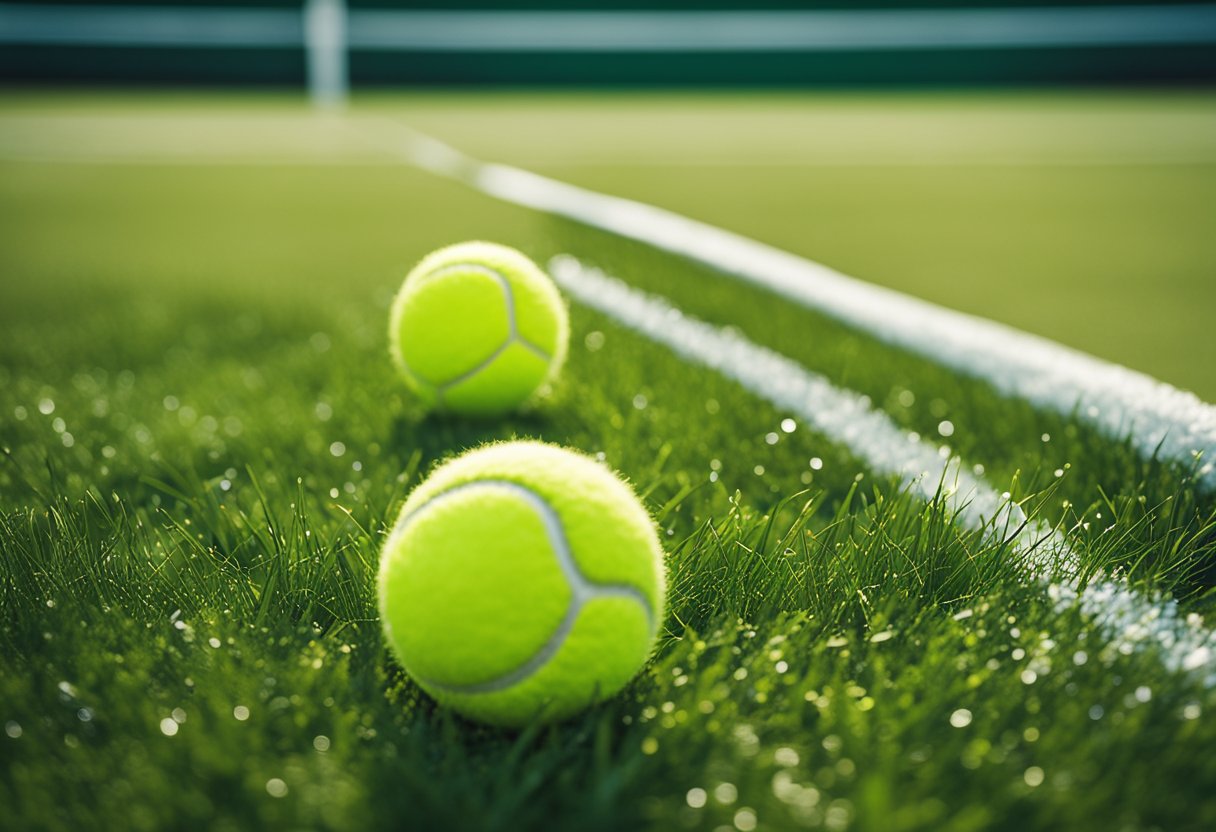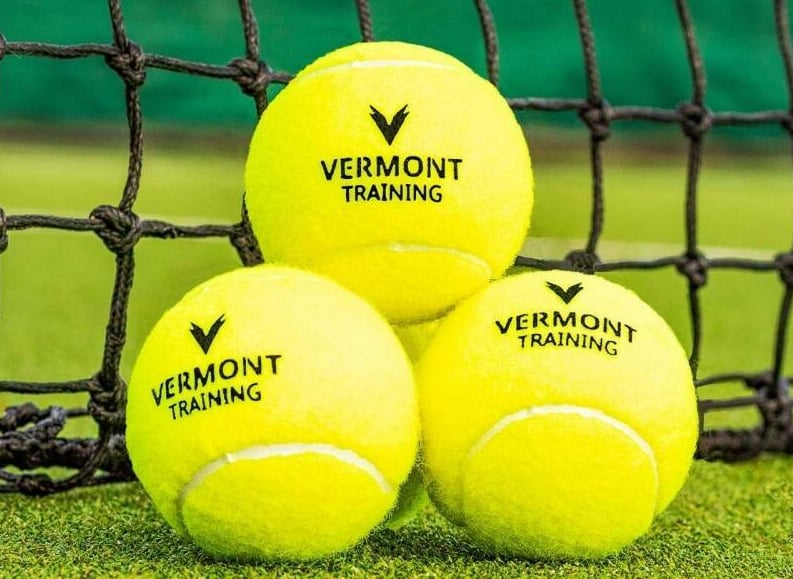Unlike traditional pressurized balls that lose bounce over time due to air leakage, pressureless balls maintain a consistent performance level. They achieve this thanks to a solid core construction that does not rely on internal air pressure.
This design makes them my preferred choice for practice sessions and recreational play.
Pressureless tennis balls are a good option for players of all levels. They offer longer-lasting playability and are less affected by external factors like temperature and altitude. These balls are great too for beginner players who require a more consistent bounce for better stroke and all round game development.
They are also suitable for use with ball machines and can be a more economical choice in the long run due to their durability.
At a glance:
- Pressureless tennis balls provide consistent performance and durability.
- They are ideal for practice and recreational play due to their consistent bounce.
- Regular care and understanding of the player’s needs ensure optimal use of pressureless tennis balls.
Fundamentals:
Tennis players often choose between two main types of tennis balls: pressurized and pressureless. The differences in their internal structure dramatically influence their performance and characteristics.
Differences Between Ball Types:
Pressurized tennis balls have a hollow core filled with air at a higher pressure than the surrounding atmosphere. This creates a ball that is initially lively and has a high bounce.
Pressureless balls, on the other hand, lack this internal air pressure. Instead, they rely on a solid rubber core which makes them less bouncy at first but more durable over time. As a pressureless ball wears down, its bounce can actually increase.
Pressurized Balls:
- High internal air pressure
- High initial bounce that decreases over time
- Shorter lifespan
Pressureless Balls:
- No internal high pressure
- Low initial bounce that increases over time
- Longer lifespan due to durable rubber

Characteristics and Properties:
The rubber used in pressureless tennis balls contributes significantly to their characteristics. Since they don’t contain pressurized air, their bounce and performance are consistent, regardless of external atmospheric conditions. This consistency makes them ideal for practice sessions or ball machines.
Moreover, since they deteriorate from the outside in, rather than losing internal pressure, their lifespan is considerably longer. This can be more cost-effective for frequent players.
- Rubber Core: Delivers a more uniform feel and bounce over the ball’s lifespan.
- Bounce Consistency: Maintains performance level, especially under varying weather conditions.
- Performance: Better suited for practice rather than competitive play due to a heavier feel and slower speed.
Benefits:
Pressureless tennis balls offer distinct advantages for players seeking equipment that withstands wear over time and performs across various types of playing surfaces. They are particularly valued for their enduring playability and adaptability.
Durability and Longevity
Pressureless tennis balls differentiate themselves through durability and longevity. Unlike pressurized balls, they do not have a pressurized air core and thus do not lose bounce over time. They provide a consistent performance that can often far outlast their pressurized counterparts.
- Durability: The lack of internal pressure means the ball’s structure deteriorates more slowly. This makes them ideal for practice sessions and coaching drills where a high volume of balls is used.
- Longevity: They tend to maintain their bounce and playability much longer, which means players do not need to replace them as frequently as they would with pressurized balls.
Versatility Across Court Surfaces
Players find that pressureless tennis balls offer impressive versatility, suitable for a range of court surfaces and conditions.
- All Court Surfaces: They are designed to provide a consistent playing experience on hard courts, indoor courts, and even at high altitudes. Their performance doesn’t vary much from one surface to another, making them a versatile choice for players who play on multiple types of courts.
- Performance: They are less affected by surface friction or changes in environment, ensuring reliable response whether the court surface is fast or slow.
Choosing the Right Ball Type:

When selecting pressureless tennis balls, consider factors such as usage purpose and brand preferences to make a good choice.
Selecting for Practice or Training
For individuals or coaches focused on improving skills, practice balls are an excellent choice. These balls are designed to maintain a consistent bounce over time, making them suitable for repetitive drills.
In contrast to standard balls that lose pressure and effectiveness, pressureless training balls, such as the Tourna Pressureless tennis balls, offer longevity and are often sold in bulk, providing a cost-effective solution for extensive training sessions.
Comparison Across Brands and Models
When comparing brands, it’s essential to review the performance characteristics of each model.
For instance, Penn Pressureless tennis balls are widely recognized for their durability and consistent performance across various court surfaces. Here’s a brief comparison in tabular form:
| Brand | Model | Durability | Court Surface Compatibility |
|---|---|---|---|
| Penn Pressureless | Practice/Training | High | All |
| Tourna Pressureless | Practice/Training | Moderate | All |
In evaluating the options, you should also check out customer reviews as they provide real-world insights into the longevity and playability of the balls.
Remember, each brand and model offers unique features, so the player’s skill level and the intended use should guide the final selection.
Playing with Pressureless Tennis Balls:
Pressureless tennis balls provide a unique playing experience, maintaining consistent performance over time. They are particularly suited for players who value longevity in their tennis equipment.
Performance on Different Court Types
Hard Courts:
- Consistency: Pressureless tennis balls offer reliable bounces on hard court surfaces.
- Durability: Their robust construction withstands the abrasive nature of hard courts.
Grass Courts:
- Speed: On grass courts, pressureless balls tend to move faster due to less friction.
- Playability: They provide a more consistent bounce compared to pressurized balls, which can behave unpredictably on grass surfaces.
| Court Type | Characteristics | Performance |
|---|---|---|
| Hard Courts | Durable, Consistent bounce | High durability and consistent performance |
| Grass Courts | Fast, Unpredictable bounce | Increased speed, improved playability |
Adjusting to the Weight and Speed
Weight:
- Heavier Feel: Pressureless balls have a heavier feel, which might affect swing timing.
Speed:
- Initial Speed: Players may notice that pressureless balls start off less lively.
- Long-term Speed: Their speed becomes more consistent as they are used more frequently.
Players should practice with the balls in their mesh bags, adjusting their play to match the distinct weight and speed of pressureless tennis balls on different court types.
Care and Maintenance:
Proper care and maintenance of pressureless tennis balls can greatly extend their lifespan and ensure consistent performance. Heeding the optimal storage conditions and effective use can help the balls last longer and remain reliable during play.
Optimal Storage Conditions
To maintain the integrity of pressureless tennis balls, they should be stored in a cool, dry place away from direct sunlight and moisture. Extreme temperatures and humidity can degrade the rubber and felt, leading to premature wear.
- Temperature: Between 60-75°F (15-24°C)
- Humidity: Moderate, ideally around 50%
Maximizing the Life of Your Balls
One can maximize the life and performance of their tennis balls through proper care on and off the court.
- Surface Matching: Use the balls on appropriate court surfaces to minimize wear.
- Clay courts can be gentler on balls compared to hard courts.
- Rotation: Rotate between multiple sets of balls to distribute wear evenly.
Your Questions Answered:
What are the benefits of using these balls for practice?
Pressureless tennis balls are less prone to losing bounce over time, which makes them an economical choice for practice sessions. They tend to have a longer life span than their pressurized counterparts, providing consistent performance.
How do pressureless balls differ from pressurized ones in terms of playability?
Pressureless tennis balls typically have a firmer feel and less initial bounce than pressurized balls. Over time, as pressurized balls lose their bounce due to air leakage, pressureless balls may actually gain bounce as their rubber shell softens with use.
Are there specific brands of pressureless balls recommended for beginners?
Several brands offer pressureless tennis balls that are suitable for beginners. Brands like Tretorn and Gamma are popular choices, offering durable options that can withstand extensive practice sessions.
How long do these balls typically last before they need to be replaced?
The longevity of pressureless tennis balls can vary, but they generally last until the felt covering wears out.
On average, they can withstand extensive use over several months to a year, depending on frequency of play and court surface.
Can they be used in standard tennis matches or are they solely for practice?
Pressureless tennis balls are mainly used for practice due to their different performance characteristics.
However, they are acceptable for casual matches, especially where durability is a priority over the exact specifications of pressurized match balls.
